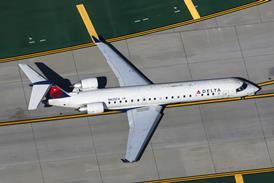It is clear that US business travellers are still staying away in droves Less certain is when they will return and exactly what initiatives the major carriers will need to take to entice back a reluctant corporate America
Corporate travel managers and industry analysts remain divided about the prospects for recovery in the US business market. Predictions over when the traffic will return range from next year to the indefinite future. Yet they are agreed on two things. First, that any recovery cannot take place until the economy rebounds. Second, that the major US carriers will have to take active steps to encourage travellers back in place of a current strategy which appears focused more on restoring yields.
The majors, they warn, will also have to learn how to compete better against low-fare alternatives. Budget carriers now operate almost 20% of all domestic US capacity - almost three times the volume that they carried during the last aviation recession in the early 1990s.
Statistics offered by corporate travel companies on the precipitous decline of their business and on the changing fare-buying habits of business travellers demonstrate why carriers have been bleeding red ink for months. In an August survey conducted by the National Business Travel Association (NBTA) among its corporate travel manager members, 72% of respondents said their travel was below the peak levels of 2000 - the accepted benchmark for the last time that the travel market was "normal". A third of members indicated that their travel was down by 20% or more from 2000.
C Thomas Nulty, president of Navigant International, the world's second largest travel management company after American Express, says the number of business trips taken by its clients was down 20% compared to equivalent 2000 purchases. Similarly, Hal Rosenbluth of another travel management giant, Rosenbluth International, says that sales by current clients are down $1 billion from two years ago.
And Kevin Mitchell, chairman of the Business Travel Coalition (BTC), a group that lobbies on behalf of the travel interests of major corporations, says that a recent survey among members predicts business travel "will be down approximately 25% by year-end 2002 compared with 2000".
Value perception
"One problem for the major airlines is that only 45% of frequent business travellers perceive the value received from them as good or very good, compared with 80% for low-fare airlines," Mitchell says. "Against a backdrop of perceived sky-high business airfares, the majority of business people still travelling are choosing either low-fare airlines or non refundable tickets on the majors."
A report issued in early September by American Express supports Mitchell's findings, explaining that business travellers are increasingly using leisure fares. This trend, it says, has helped companies "turn back the clock in the second quarter to average airfare bills not seen in four years".
The report adds: "Airlines have slashed leisure fares so precipitously, while keeping business fares relatively stable and high, that the fares directed at road warriors are now six times higher than those traditionally targeted at consumers. But companies and their travellers are shopping for bargains. It's a sea change in the way US business buys travel services."
Andrew Winterton, vice-president of supplier relations with American Express, advocates drastically narrowing the business-leisure fare gap. "At the end of the day, I think leisure traffic has to contribute more to airline revenue, so the cost of operating the airlines isn't so much on the shoulders of corporate America," he said. "There has to be a levelling of the playing field."
Rosenbluth says that business travellers are not only being pushed to the back of the aircraft by the current fares structure, but that airlines are providing such an unpleasant service that a rising number are avoiding travel altogether.
"I'm not sure people like flying any more, since it's not an enjoyable experience. Airlines need to have a complete philosophical and attitudinal change, they have to recognise they have different competitors than in the past - e-mail, teleconferencing and video-conferencing," he says, adding that they have to change service attitudes both on the ground and in flight: "They've got to become a lot friendlier, because people don't feel as welcome as they'd like."
Airline pricing criticised
Meanwhile, most majors have reacted with a severe tightening of the rules governing the use of non-refundable tickets, essentially matching the US Airways initiative in late summer. It is a move which carriers clearly believe can help strengthen revenues, since the new restrictions make these fares far less attractive to business travellers. However, some industry analysts believe these changes represent a tremendous mistake.
Apart from restrictions on non-refundable tickets, some carriers have also started to charge fees for use of paper rather than electronic tickets and have made other changes that limit availability of certain corporate discounts. "It may make sense from a financial perspective but not from a long-term perspective," says one official, requesting anonymity. "They don't encourage more people to travel, since they make business travel more expensive and more difficult. These moves are suppressing business travel demand."
These steps, says Mitchell, are effectively raising business fares "at a time when they need to go in the opposite direction". He adds that carriers have "so angered their best customers with these moves that they're in a mood to cut travel more, go on low-fare airlines or use video-conferencing".
Jamie Baker, airline analyst for JP Morgan, believes it is necessary for major carriers to increase their seats - rather than continue with post-11 September capacity reductions - if they are tocompete with low-fare airlines.
In a report issued in late August, Baker writes:"We believe the industry has entered a prolonged period of low-fare dominance; just as the business traveller ruled the day for the past four years, so we think the leisure/restrained business traveller will rule for the foreseeable future. As such, it is difficult to understand how less capacity serves the industry's need to generate revenue. Obviously, the airlines can't make it up on volume if they are continually reducing capacity."
Baker believes that carriers will slowly realise that "more is more" - that low pricing can only be offset by high volumes. He cites the American Airlines move to remove first class from certain aircraft as "a small step in the right direction", while its desire to increase aircraft utilisation by moving to an omni-bank structure at its Dallas-Fort Worth hub provides "further evidence".
Looking beyond the current morass, the experts disagree about when a recovery in business travel will actually take place, although no one seems to think it will happen soon and most seem to feel the key catalyst will necessarily be economic recovery.
This view is supported by the recent NBTA survey, 72% of the respondents to which believe that for business travel to return to "normal" levels, a stable economy will have to be in place. Interestingly, only 45% believe that airline price reform will be a necessary precursor to a business travel renaissance.
On the issue of timing, the NBTA respondents expressed a belief that recovery will take more than a year. This response represents a decline in optimism from last March's survey, when respondents said they expected travel to return to normal in six to 12 months.
For his part, Rosenbluth predicts a recovery will take place "in the last part of 2003", although he is quick to add that this scenario assumes the economy will revive by mid-2003 and there are no further terrorist attacks or war with Iraq.
Nulty projects a recovery to 2000 business travel levels by late 2003, an upturn which, he says, "will be all economically driven". However, he also says that if a war occurs, "all bets are off".
Business travel rebound
Like Nulty, Michael Linenberg, analyst for Merrill Lynch, believes business travel will rebound once "companies are in the black. When there's earnings growth again, corporate travel managers will loosen up their purse strings."
JP Morgan's Baker is more bearish, saying: "It's safe to say airlines won't return to the high-yield environment of 1999-2000 in the foreseeable future. At the height of the Internet-led economic bubble, corporations showed little travel restraint. Today the exact opposite is true. But even with a robust economic recovery, it's unlikely corporate travellers will unlearn their good habits."
Mitchell believes there is little hope for a rebound in business travel "any time soon". If the new restrictive policies stay in place, he warns, then travel levels will not return to 2000 levels until 2004 or beyond.
"Five years ago, low-fare carriers flew dirty aircraft and were poorly run," he says. "Today, they're well-run and have fare structures business travellers understand and have embraced. There's so much opportunity in the next 18 months for them to gain market share."
Nulty at Navigant feels that even when business travel comes back in vogue, the smaller corporate accounts and unmanaged business travellers will continue to use low-fare carriers.
Such sentiments notwithstanding, several observers believe major carriers will continue to appeal to business travellers more than their low-fare counterparts. Linenberg believes corporations that have volume deals with major carriers will still rely on them in order to maintain their discounts.
Nulty agrees, noting that large corporations can often negotiate discounted rates from established carriers similar to those offered by low-fare airlines. "Given the choice between the two, many travellers prefer an airline with hubs, a frequent flier programme, more reliable service and more service to more places," he says. Business travellers today find flight upgrades more attractive than frequent flier miles and those, he says, are something that only full-service airlines can offer.
Source: Airline Business























